多相流模型数值模拟(中文)
- 格式:pdf
- 大小:2.50 MB
- 文档页数:45
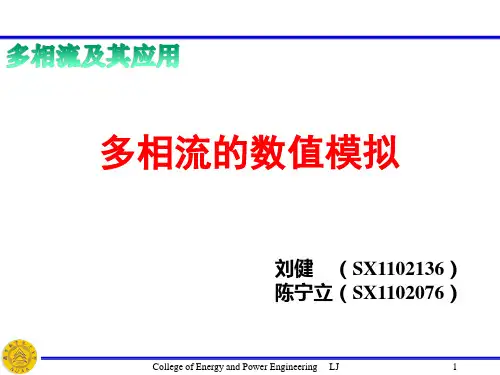
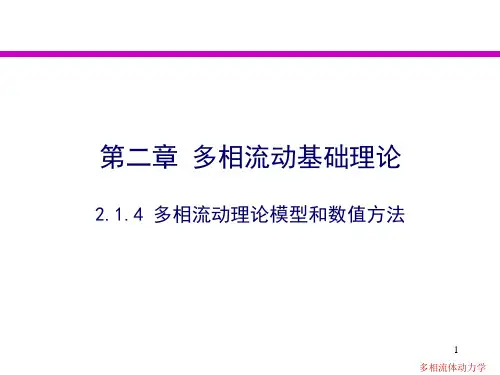


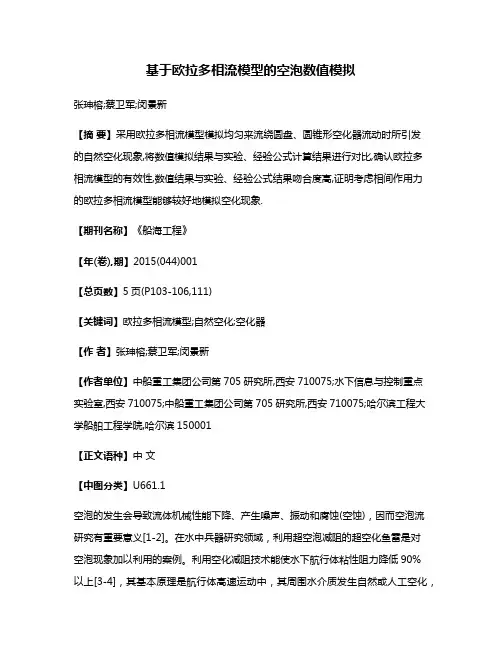
基于欧拉多相流模型的空泡数值模拟张珅榕;蔡卫军;闵景新【摘要】采用欧拉多相流模型模拟均匀来流绕圆盘、圆锥形空化器流动时所引发的自然空化现象,将数值模拟结果与实验、经验公式计算结果进行对比,确认欧拉多相流模型的有效性,数值结果与实验、经验公式结果吻合度高,证明考虑相间作用力的欧拉多相流模型能够较好地模拟空化现象.【期刊名称】《船海工程》【年(卷),期】2015(044)001【总页数】5页(P103-106,111)【关键词】欧拉多相流模型;自然空化;空化器【作者】张珅榕;蔡卫军;闵景新【作者单位】中船重工集团公司第705研究所,西安710075;水下信息与控制重点实验室,西安710075;中船重工集团公司第705研究所,西安710075;哈尔滨工程大学船舶工程学院,哈尔滨150001【正文语种】中文【中图分类】U661.1空泡的发生会导致流体机械性能下降、产生噪声、振动和腐蚀(空蚀),因而空泡流研究有重要意义[1-2]。
在水中兵器研究领域,利用超空泡减阻的超空化鱼雷是对空泡现象加以利用的案例。
利用空化减阻技术能使水下航行体粘性阻力降低90%以上[3-4],其基本原理是航行体高速运动中,其周围水介质发生自然或人工空化,高粘性流体介质被低粘性流体介质——水蒸气所取代,从而降低航行体摩擦阻力[5]。
空泡的形态对水下航行体流体性能有重要影响。
实验受限于测量仪器,许多物理量难以或无法测量。
随着计算机硬件能力提升,CFD数值模拟仿真技术得到越来越多的关注。
目前,已有大量基于均相流模型的空泡数值模拟研究,其假设在流场同一位置,各相速度、压力相同,仅建立混合相的连续方程和动量守恒方程。
由于各相之间速度滑移很小,因而均相流模型将多相流动看成单相流动具备一定合理性。
但汽液两相物理属性不同,均相流模型的物理机制不及欧拉多相流模型的完善。
利用欧拉模型处理空泡流问题,由于考虑相间速度滑移、作用力等因素,原理比较复杂,相关物理机理尚不完善,还未获得广泛运用。
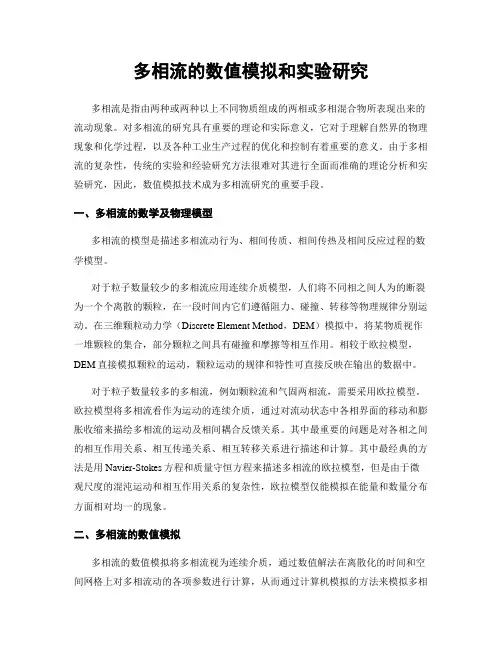
多相流的数值模拟和实验研究多相流是指由两种或两种以上不同物质组成的两相或多相混合物所表现出来的流动现象。
对多相流的研究具有重要的理论和实际意义,它对于理解自然界的物理现象和化学过程,以及各种工业生产过程的优化和控制有着重要的意义。
由于多相流的复杂性,传统的实验和经验研究方法很难对其进行全面而准确的理论分析和实验研究,因此,数值模拟技术成为多相流研究的重要手段。
一、多相流的数学及物理模型多相流的模型是描述多相流动行为、相间传质、相间传热及相间反应过程的数学模型。
对于粒子数量较少的多相流应用连续介质模型,人们将不同相之间人为的断裂为一个个离散的颗粒,在一段时间内它们遵循阻力、碰撞、转移等物理规律分别运动。
在三维颗粒动力学(Discrete Element Method,DEM)模拟中,将某物质视作一堆颗粒的集合,部分颗粒之间具有碰撞和摩擦等相互作用。
相较于欧拉模型,DEM直接模拟颗粒的运动,颗粒运动的规律和特性可直接反映在输出的数据中。
对于粒子数量较多的多相流,例如颗粒流和气固两相流,需要采用欧拉模型。
欧拉模型将多相流看作为运动的连续介质,通过对流动状态中各相界面的移动和膨胀收缩来描绘多相流的运动及相间耦合反馈关系。
其中最重要的问题是对各相之间的相互作用关系、相互传递关系、相互转移关系进行描述和计算。
其中最经典的方法是用Navier-Stokes方程和质量守恒方程来描述多相流的欧拉模型,但是由于微观尺度的混沌运动和相互作用关系的复杂性,欧拉模型仅能模拟在能量和数量分布方面相对均一的现象。
二、多相流的数值模拟多相流的数值模拟将多相流视为连续介质,通过数值解法在离散化的时间和空间网格上对多相流动的各项参数进行计算,从而通过计算机模拟的方法来模拟多相流的运动行为。
数值模拟的过程通常包括以下几个方面的内容:建立数学模型、数值解法、模型验证和优化等。
1.建立数学模型多相流动的数学模型是研究多相流动过程的基础,在多相流动的数值模拟中,合适的模型对于准确得到各相的体积分数、速度以及温度等参数具有重要意义。
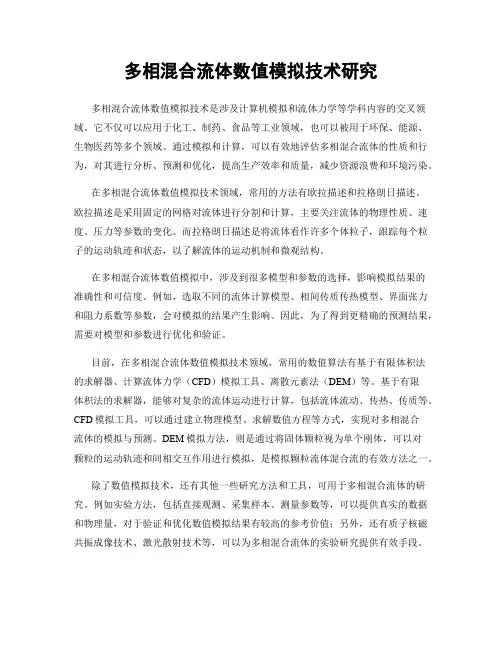
多相混合流体数值模拟技术研究多相混合流体数值模拟技术是涉及计算机模拟和流体力学等学科内容的交叉领域。
它不仅可以应用于化工、制药、食品等工业领域,也可以被用于环保、能源、生物医药等多个领域。
通过模拟和计算,可以有效地评估多相混合流体的性质和行为,对其进行分析、预测和优化,提高生产效率和质量,减少资源浪费和环境污染。
在多相混合流体数值模拟技术领域,常用的方法有欧拉描述和拉格朗日描述。
欧拉描述是采用固定的网格对流体进行分割和计算,主要关注流体的物理性质、速度、压力等参数的变化。
而拉格朗日描述是将流体看作许多个体粒子,跟踪每个粒子的运动轨迹和状态,以了解流体的运动机制和微观结构。
在多相混合流体数值模拟中,涉及到很多模型和参数的选择,影响模拟结果的准确性和可信度。
例如,选取不同的流体计算模型、相间传质传热模型、界面张力和阻力系数等参数,会对模拟的结果产生影响。
因此,为了得到更精确的预测结果,需要对模型和参数进行优化和验证。
目前,在多相混合流体数值模拟技术领域,常用的数值算法有基于有限体积法的求解器、计算流体力学(CFD)模拟工具、离散元素法(DEM)等。
基于有限体积法的求解器,能够对复杂的流体运动进行计算,包括流体流动、传热、传质等。
CFD模拟工具,可以通过建立物理模型、求解数值方程等方式,实现对多相混合流体的模拟与预测。
DEM模拟方法,则是通过将固体颗粒视为单个刚体,可以对颗粒的运动轨迹和间相交互作用进行模拟,是模拟颗粒流体混合流的有效方法之一。
除了数值模拟技术,还有其他一些研究方法和工具,可用于多相混合流体的研究。
例如实验方法,包括直接观测、采集样本、测量参数等,可以提供真实的数据和物理量,对于验证和优化数值模拟结果有较高的参考价值;另外,还有质子核磁共振成像技术、激光散射技术等,可以为多相混合流体的实验研究提供有效手段。
多相混合流体数值模拟技术的研究发展越来越迅速,应用范围也越来越广泛。
在实际应用中,需要密切关注模型的可靠性、精度和实用性等因素,仍需进一步完善和优化模型和计算方法。

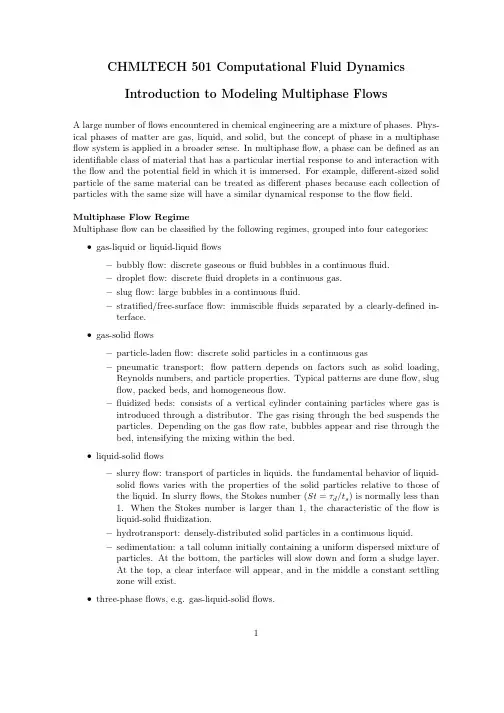
CHMLTECH501Computational Fluid Dynamics Introduction to Modeling Multiphase FlowsA large number offlows encountered in chemical engineering are a mixture of phases.Phys-ical phases of matter are gas,liquid,and solid,but the concept of phase in a multiphase flow system is applied in a broader sense.In multiphaseflow,a phase can be defined as an identifiable class of material that has a particular inertial response to and interaction with theflow and the potentialfield in which it is immersed.For example,different-sized solid particle of the same material can be treated as different phases because each collection of particles with the same size will have a similar dynamical response to theflowfield. Multiphase Flow RegimeMultiphaseflow can be classified by the following regimes,grouped into four categories:•gas-liquid or liquid-liquidflows–bubblyflow:discrete gaseous orfluid bubbles in a continuousfluid.–dropletflow:discretefluid droplets in a continuous gas.–slugflow:large bubbles in a continuousfluid.–stratified/free-surfaceflow:immisciblefluids separated by a clearly-defined in-terface.•gas-solidflows–particle-ladenflow:discrete solid particles in a continuous gas–pneumatic transport:flow pattern depends on factors such as solid loading, Reynolds numbers,and particle properties.Typical patterns are duneflow,slugflow,packed beds,and homogeneousflow.–fluidized beds:consists of a vertical cylinder containing particles where gas is introduced through a distributor.The gas rising through the bed suspends theparticles.Depending on the gasflow rate,bubbles appear and rise through thebed,intensifying the mixing within the bed.•liquid-solidflows–slurryflow:transport of particles in liquids.the fundamental behavior of liquid-solidflows varies with the properties of the solid particles relative to those ofthe liquid.In slurryflows,the Stokes number(St=τd/t s)is normally less than1.When the Stokes number is larger than1,the characteristic of theflow isliquid-solidfluidization.–hydrotransport:densely-distributed solid particles in a continuous liquid.–sedimentation:a tall column initially containing a uniform dispersed mixture of particles.At the bottom,the particles will slow down and form a sludge layer.At the top,a clear interface will appear,and in the middle a constant settlingzone will exist.•three-phaseflows,e.g.gas-liquid-solidflows.1Each of theseflow regimes is illustrated in Figure(1).Figure1:Multiphase Flow Regimes.2Examples of Multiphase SystemsSpecific examples of each regime are listed below:•Bubblyflow examples:absorbers,aeration,air lift pumps,cavitation,evaporators,flotation,scrubbers•Dropletflow examples:absorbers,atomizers,combustors,cryogenic pumping,dryers, evaporation,gas cooling,scrubbers•Slugflow examples:large bubble motion in pipes or tanks.•Stratified/free-surfaceflow examples:sloshing in offshore separator devices,boiling and condensation in nuclear reactors•Particle-ladenflow examples:cyclone separators,air classifiers,dust collectors,and dust-laden environmentalflows•Pneumatic transport examples:transport of cement,grains,and metal powders •Fluidized bed examples:fluidized bed reactors,circulatingfluidized beds•Slurryflow examples:slurry transport,mineral processing•Hydrotransport examples:mineral processing,biomedical and physiochemicalfluid systems•Sedimentation examples:mineral processing3APPROACHES TO MULTIPHASE MODELINGAdvances in computationalfluid mechanics have provided the basis for further insight into the dynamics of multiphaseflows.Currently there are two approaches for the numerical cal-culation of multiphaseflows:the Euler-Langrange approach and the Euler-Euler approach. The Euler-Lagrange ApproachThe Lagrangian discrete phase model(in FLuent)follows the Euler-Langrange approach. Thefluid phase is treated as a continuum by solving the time-averaged Navier-Stokes equa-tions,while the dispersed phase is solved by tracking a large number of particles,bubbles, or droplets through the calculatedflowfield.The dispersed phase can exchange momentum, mass,and energy with thefluid phase.A fundamental assumption made in this model is that the dispersed second phase occu-pies a low volume fraction,even though high mass loading(m particles m fluid)is acceptable. The particle or droplet trajectories are computed individually at specified intervals during thefluid phase calculation.This makes the model appropriate for the modeling of spray dryers,coal and liquid combustion,and some particle-ladenflows,but inappropriate for the modeling of liquid-liquid mixtures,fluidized beds,or any application where the volume fraction of the second phase is not negligible.The Euler-Euler ApproachIn the Euler-Euler approach,the different phases are treated mathematically as interpene-trating continua.Since the volume of a phase cannot be occupied by the other phases,the concept of phasic volume fraction is introduced.These volume fractions are assumed to be continuous functions of space and time and their sum is equal to one.Conservation equa-tions for each phase are derived to obtain a set of equations,which have similar structure for all phases.These equations are closed by providing constitutive relations that are obtained from empirical information,or,in the case of granularflows,by application of kinetic energy.Three different Euler-Euler multiphase models(are available in FLUENT):the volume offluid(VOF),the mixture model,and Eulerian model.The VOF ModelThe VOF model is a surface-tracking technique applied to afixed Eulerian mesh.It is designed for two or more immisciblefluids where the position of the interface between the fluids is of interest.In the VOF model,a single set of momentum equations is shared by thefluids,and the volume fraction of each of thefluids in each computational cell is tracked throughout the domain.Applications of the VOF model include stratifiedflows,free-surface flows,filling,sloshing,the motion of large bubbles in a liquid,the motion of liquid after a dam break,the prediction of jet breakup(surface tension),and the steady or transient tracking of any liquid-gas interface.The Mixture ModelThe mixture model is designed for two or more phases(fluid or particulate).As in the Eulerian model,the phases are treated as interpenetrating continua.The mixture model solves for the mixture momentum equation and prescribes relative velocities to describe the dispersed phases.Applications of the mixture model include particle-ladenflows with low loading,bubblyflows,sedimentation,and cyclone separators.The mixture model can also4be used without relative velocities for the dispersed phases to model homogeneous multi-phaseflow.The Eulerian ModelThe Eulerian model is the most complex of the multiphase models(in FLUENT).It solves a set of n momentum and continuity equations for each phase.Coupling is achieved through the pressure and interphase exchange coefficients.The manner in which this coupling is handled depends upon the type of phases involved;granularflows,the properties are obtained from application of kinetic theory.Momentum exchange between the phases is also dependent upon the type of mixture being modeled.(FLUENT’s user-defined functions allow you to customize the calculation of the momentum exchange).Applications of the Eulerian mutiphase model include bubble columns,risers,particle suspension,andfluidized beds.5。
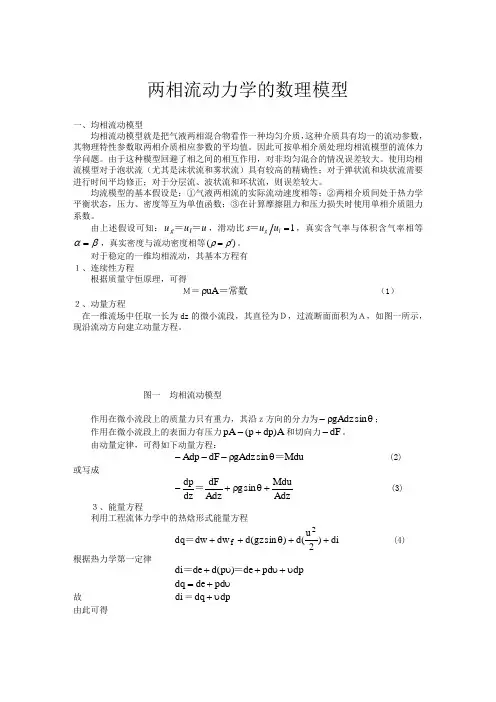
两相流动力学的数理模型一、均相流动模型均相流动模型就是把气液两相混合物看作一种均匀介质,这种介质具有均一的流动参数,其物理特性参数取两相介质相应参数的平均值。
因此可按单相介质处理均相流模型的流体力学问题。
由于这种模型回避了相之间的相互作用,对非均匀混合的情况误差较大。
使用均相流模型对于泡状流(尤其是沫状流和雾状流)具有较高的精确性;对于弹状流和块状流需要进行时间平均修正;对于分层流、波状流和环状流,则误差较大。
均流模型的基本假设是:①气液两相流的实际流动速度相等;②两相介质间处于热力学平衡状态,压力、密度等互为单值函数;③在计算摩擦阻力和压力损失时使用单相介质阻力系数。
由上述假设可知:u u u l g ==,滑动比1g l s u u ==,真实含气率与体积含气率相等αβ=,真实密度与流动密度相等()ρρ'=。
对于稳定的一维均相流动,其基本方程有 1、连续性方程根据质量守恒原理,可得M==常数uA ρ (1) 2、动量方程在一维流场中任取一长为dz 的微小流段,其直径为D,过流断面面积为A,如图一所示,现沿流动方向建立动量方程。
图一 均相流动模型作用在微小流段上的质量力只有重力,其沿z方向的分力为θρ-sin gAdz ; 作用在微小流段上的表面力有压力A )dp p (pA +-和切向力dF -。
由动量定律,可得如下动量方程:Mdu sin gAdz dF Adp =θρ--- (2) 或写成AdzMdu sin g AdzdF dz dp +θρ+-=(3)3、能量方程利用工程流体力学中的热焓形式能量方程di )2u(d )sin gz (d dwdw dq 2f ++θ++= (4)根据热力学第一定律dp pd de )p (d de di υ+υ+υ+==υ+=pd de dq 故 di =dp dq υ+ 由此可得dw )2u(d dz sin g dwdp 2f ++θ+υ-= (5)式中:dq ──单位质量流体吸收的热量,包括由外界直接吸收的热量和由机械能散失转变 成的热量;dw ──单位质量流体对外所作的功;f dw ──单位质量流体由于摩擦而散失的机械能; di ──单位质量流体焓的增量; de ──单位质量流体内能的增量; υ──两相混合物的比容,υ=ρ1。
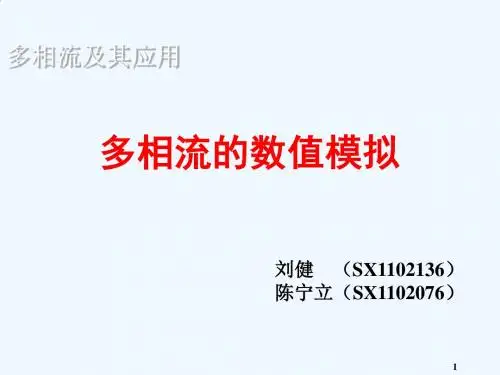
多相湍流计算模型多相流动指气体-颗粒(气-固)、液体-颗粒(液-固)、液体-气泡(液-气)、气体-液雾(气-液)和气泡-液体-颗粒(气-液-固)等两相或者三相流动,其中连续相是流体(气体或液体)、离散相是颗粒、液雾或气泡。
离散相模型解决的问题:煤粉燃烧、颗粒分离、喷雾干燥、液体燃料的燃烧等,颗粒-颗粒之间的相互作用、颗粒体积分数对连续相的影响未考虑。
湍流中颗粒处理的两种模型:Stochastic Tracking,应用随机方法来考虑瞬时湍流速度对颗粒轨道的影响,Cloud Tracking,运用统计方法来跟踪颗粒围绕某一平均轨道的湍流扩散,通过计算颗粒的系统平均运动方程得到颗粒的某个“平均轨道”。
一般气固两相流动的研究方法主要有:(1)把流体或气体当作连续介质,而将颗粒视为离散体系。
(2)把流体与颗粒都看成共同存在且相互渗透的连续介质,即把颗粒视作拟流体。
(3)近年来,在研究有化学反应的气粒两相流时,也探讨了诸如颗粒相的连续介质—轨道模型这样的综合方法。
1980—1981年在美国斯坦福大学召开了一个国际会议,对各种湍流模型在工程等温流动中的应用结果进行了评定。
就其通用性,Donaldson提出了湍流模型必须满足以下一些条件:(1)如果待模拟的项是一个张量,则模型在张量的阶数,下标的次序,张量的性质(对称性和迹为零)都和原项相同;(2)量纲上必须相同;(3)满足不变性原则。
模型表达式与坐标系的选择无关,当坐标系作伽利略变换时,模型与待模拟的量按相同的规律变化;(4)模型方程必须满足守恒定律。
在此前提下,气固两相流动的研究方法仍层出不穷,但是仍基于各种特定条件的假设。
本文将给出的模型有:单颗粒动力学模型、颗粒轨道模型、随机轨道模型多流体模型等。
1 气固两相流的流动特点1.1流动的特点1)流动类型—根据以下特征时间的比值组成的相似准则的量级判断流动的特征时间有:流动时间(停留时间)扩散驰豫时间平均运动驰豫时间流体脉动时间颗粒间碰撞时间其中vdvv ppp/ Re-=当1/<<frlττ时,为无滑移流(平衡流);当1/>>frlττ时,为强滑移底(冻结流);当1/>>Trττ时,为扩散—冻结流;当1/<<Trττ时,为扩散—平衡流;当1/<<prlττ时,为稀疏悬浮流;当1/>>prlττ时,为稠密悬浮流。
多相流与传热传质的数值模拟与优化随着科技的不断进步,计算机仿真技术得到了广泛的应用,其中涉及多相流和传热传质的数值模拟和优化技术的应用就日益广泛。
它可以解决很多传统试验法无法解决的问题,且具有省时、省力、低成本的特点,在很多科学研究领域中已得到广泛应用。
本文将从多相流与传热传质的数值模拟与优化过程中的两个重要环节出发,即模型建立和数值计算方法,结合实际工程案例加以探讨。
一、模型建立数值模拟中的模型建立是多相流与传热传质问题研究的重要环节之一。
它的正确性直接关系到计算结果的准确性。
多相流的模型一般分为两类,即欧拉-欧拉两流体模型和欧拉-拉格朗日模型,前者假定两相间具有相同的流体动力学特性,后者假定两相间存在流体动力学的差异。
对于不同的工程问题,应选择合适的多相流模型。
在建立模型时,应注意选择合适的流动方程、物理性质参数、初始条件和边界条件等。
例如,在比较流体中的微小颗粒的运动时,应使用规模化的纳细结构和粘滞性等物理性质参数,同时要精确的描述每种颗粒的大小、形状、密度和粘性等特性,以确保模型的准确性。
二、数值计算方法数值计算方法是多相流与传热传质问题研究的重要环节之一。
它是指利用计算机对建立好的模型进行数值计算,得到多相流与传热传质过程的各种物理量分布规律和优化措施,而数值计算的精确度、高效性和时间成本直接关系到计算结果的准确性。
目前,多数多相流和传热传质的计算方法主要采用有限体积法、有限差分法或边界元法等数值计算技术。
有限体积法是目前较为常用的数值计算方法,它采用体积法对物理量进行离散化处理,通过差分方程求解等方法,得到物理量的分布规律。
此外,还可利用计算流体力学(CFD)等工具进行数值计算,以获得更为精确的计算结果。
但需要注意的是,由于计算精力和计算机能力等因素的限制,计算范围和计算时间等仍然存在一定的局限性。
三、实际工程应用多相流与传热传质的数值模拟和优化技术在很多领域得到了广泛的应用。
例如,在化工、能源、环保、航天、建筑等领域中,多相流模型的应用已成为科学研究和工程实践的重要手段。